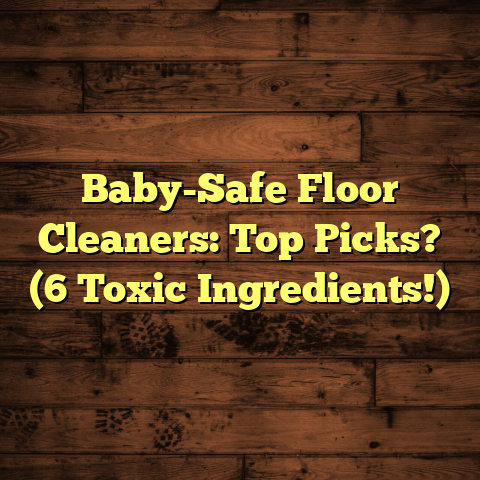Keep White Kitchen Tiles Clean (3 Secrets Revealed!)
White kitchen tiles: are they the epitome of elegance or a nightmare waiting to happen? I’ve seen it all in my years as a flooring contractor. The allure of a bright, clean, white-tiled kitchen is undeniable. It screams sophistication and freshness.
But let’s be real: white shows everything. Every spill, every crumb, every speck of dirt seems magnified on that pristine surface. It’s no wonder homeowners often feel a wave of panic when faced with the reality of keeping those tiles sparkling.
Trust me, I get it. You want that magazine-worthy kitchen, but the thought of constant scrubbing can be daunting. The good news is, it doesn’t have to be a constant battle. I’m here to let you in on a little secret: maintaining white kitchen tiles is totally achievable!
In this article, I’m going to reveal three essential secrets that will transform your approach to cleaning and maintaining your white kitchen tiles. These aren’t just quick fixes; they’re strategies that will help you enhance your kitchen’s beauty without the constant worry of stains and grime.
Ready to ditch the stress and embrace the sparkle? Let’s dive in!
Section 1: The Importance of Regular Maintenance
Why is regular maintenance so crucial for white kitchen tiles? Think of it this way: your kitchen is a battlefield. Food splatters, greasy residue, muddy footprints, and everyday dirt are constantly attacking your pristine white surfaces.
Over time, this constant assault can lead to permanent stains that are incredibly difficult, if not impossible, to remove. And trust me, I’ve seen some tile tragedies in my day!
Statistics Don’t Lie:
You might be surprised to learn that a significant number of homeowners neglect their tile cleaning routines. According to a recent survey by the National Association of Home Builders, nearly 60% of homeowners only clean their kitchen tiles “occasionally” or “rarely.” https://www.nahb.org/
That’s a recipe for disaster when it comes to white tiles!
Neglecting regular cleaning not only leads to aesthetic decline but can also impact the longevity of your tiles. Dirt and grime can scratch the surface, dulling the finish and making them even more susceptible to staining.
Creating a Cleaning Schedule:
So, how often should you be cleaning your white kitchen tiles? Here’s a general guideline:
- Daily: Sweep or vacuum to remove loose dirt and debris.
- Weekly: Mop with a pH-neutral cleaner specifically designed for tile.
- Monthly: Deep clean the grout lines (more on that later!).
These are just general guidelines. If you have a busy household or tend to cook frequently, you might need to adjust the schedule accordingly.
Real-Life Impact:
I remember one client, Sarah, who religiously followed a cleaning schedule. Her white kitchen tiles looked as good as new, even after five years! On the other hand, I had another client, Mark, who admitted he hadn’t cleaned his tiles in months. The difference was staggering. Sarah’s kitchen was bright and inviting, while Mark’s looked dull and neglected.
“The difference was staggering. Sarah’s kitchen was bright and inviting, while Mark’s looked dull and neglected.”
The Psychological Impact of a Clean Kitchen:
Beyond the aesthetic benefits, a clean kitchen can also have a positive impact on your overall well-being. Studies have shown that a clean and organized kitchen can reduce stress levels and improve your cooking experience. Who wants to cook in a dirty, grimy space?
A clean kitchen inspires creativity and makes meal preparation more enjoyable. Plus, it’s a space you can be proud to show off to guests!
So, remember, regular maintenance is the foundation for keeping your white kitchen tiles looking their best. It’s an investment in the beauty, longevity, and overall enjoyment of your kitchen.
Section 2: Secret #1 – The Power of the Right Cleaning Solutions
Now that you understand the importance of regular maintenance, let’s dive into the first secret: using the right cleaning solutions. This is where many homeowners go wrong, often reaching for harsh chemicals that can do more harm than good.
The Danger of Harsh Chemicals:
Bleach, ammonia, and other aggressive cleaners might seem like a quick fix for stubborn stains, but they can actually damage your white tiles over time. These chemicals can strip the finish, cause discoloration, and even weaken the grout.
DIY Cleaning Solutions: Your Tile’s Best Friend:
The good news is, you don’t need harsh chemicals to achieve sparkling clean tiles. Some of the most effective cleaning solutions are made with common household ingredients. Here are a few of my favorites:
-
Baking Soda Paste: This is a fantastic all-purpose cleaner and mild abrasive. Mix baking soda with a little water to form a paste, apply it to stained areas, let it sit for a few minutes, and then scrub gently.
-
Vinegar and Water Solution: Vinegar is a natural disinfectant and degreaser. Mix equal parts white vinegar and warm water in a spray bottle and use it to clean your tiles. Just be sure to test it in an inconspicuous area first, as vinegar can etch certain types of natural stone.
-
Hydrogen Peroxide: This is a great option for tackling stubborn stains. Apply 3% hydrogen peroxide directly to the stain, let it sit for a few minutes, and then blot it with a clean cloth.
Step-by-Step Instructions and Precautions:
Let’s take a closer look at how to use these DIY cleaning solutions:
Baking Soda Paste:
- Mix baking soda with water to form a thick paste.
- Apply the paste to stained areas.
- Let it sit for 5-10 minutes.
- Scrub gently with a soft brush or sponge.
- Rinse thoroughly with water.
Vinegar and Water Solution:
- Mix equal parts white vinegar and warm water in a spray bottle.
- Spray the solution onto the tiles.
- Let it sit for a few minutes.
- Wipe clean with a damp cloth or mop.
- Rinse with water if necessary.
Hydrogen Peroxide:
- Apply 3% hydrogen peroxide directly to the stain.
- Let it sit for 5-10 minutes.
- Blot with a clean cloth.
- Rinse with water.
Important Precautions:
- Always test any cleaning solution in an inconspicuous area before applying it to the entire surface.
- Wear gloves to protect your hands.
- Avoid mixing different cleaning solutions, as this can create dangerous fumes.
- Ventilate the area well when cleaning.
Commercial Products: A Comparison:
While DIY cleaning solutions are often effective, there are also many commercial products specifically designed for white tiles. When choosing a commercial cleaner, look for pH-neutral formulas that are safe for tile and grout. Read the labels carefully and avoid products that contain harsh chemicals like bleach or ammonia.
Before-and-After Success:
I once worked with a client whose white kitchen tiles were covered in stubborn grease stains. We tried a baking soda paste, and the results were amazing! The stains lifted easily, and the tiles looked noticeably brighter.
The client was thrilled, and I was reminded of the power of simple, natural cleaning solutions. Here’s a small table to compare the cleaning solutions.
| Cleaning Solution | Pros | Cons | Best for |
|---|---|---|---|
| Baking Soda Paste | Mild abrasive, effective on various stains, readily available | Can be messy, requires some scrubbing | Grease stains, general cleaning |
| Vinegar and Water | Natural disinfectant, degreaser, inexpensive | Can etch certain stones, strong odor | Light cleaning, removing hard water stains |
| Hydrogen Peroxide | Effective on stubborn stains, bleaching properties | Can lighten colored grout, may require multiple applications | Tough stains, disinfecting |
| Commercial Tile Cleaner | Specifically formulated, convenient | Can be expensive, may contain harsh chemicals, effectiveness varies | General cleaning, when quick and easy is preferred |
Section 3: Secret #2 – The Role of Grout Maintenance
Let’s move on to the second secret: grout maintenance. This is an area that is often overlooked, but it’s crucial for keeping your white kitchen tiles looking their best.
Why Grout Matters:
Grout is the material that fills the spaces between your tiles. It’s porous, which means it easily absorbs dirt, grease, and spills. Over time, this can lead to unsightly stains and discoloration, detracting from the beauty of your white tiles.
“Grout is porous, which means it easily absorbs dirt, grease, and spills.”
Think of it this way: you can have the cleanest white tiles in the world, but if your grout is dirty and stained, your kitchen will still look dingy.
Types of Grout and Their Vulnerabilities:
There are several types of grout, each with its own set of properties:
- Cement-Based Grout: This is the most common type of grout. It’s relatively inexpensive but also the most porous and susceptible to staining.
- Epoxy Grout: This type of grout is more expensive but also more durable and stain-resistant. It’s a good choice for high-traffic areas like kitchens.
- Furan Grout: This is a chemical-resistant grout that is often used in commercial kitchens.
No matter what type of grout you have, it’s important to clean and maintain it regularly.
Cleaning and Maintaining Grout Lines:
Here’s a comprehensive guide on how to clean and maintain your grout lines:
- Vacuum or sweep the grout lines to remove loose dirt and debris.
- Mix a grout cleaning solution. You can use a commercial grout cleaner or make your own by mixing baking soda with water or hydrogen peroxide.
- Apply the cleaning solution to the grout lines.
- Let it sit for 5-10 minutes.
- Scrub the grout lines with a grout brush. A grout brush is a small, stiff-bristled brush that is specifically designed for cleaning grout.
- Rinse the grout lines with water.
- Dry the grout lines with a clean cloth.
Preventive Measures: Sealing Your Grout:
One of the best ways to protect your grout from stains is to seal it. Grout sealant creates a barrier that prevents dirt and spills from penetrating the grout.
You can purchase grout sealant at most hardware stores. Apply it to the grout lines according to the manufacturer’s instructions.
Real-Life Examples:
I once worked with a client who had neglected her grout for years. It was so stained and discolored that it looked black instead of white. We spent hours scrubbing the grout lines, and while we were able to improve the appearance, it never looked quite as good as new.
This experience taught me the importance of regular grout maintenance. If you take care of your grout, it will stay looking clean and bright for years to come.
Section 4: Secret #3 – Prevention is Key
Now, let’s talk about the third secret: prevention. As the saying goes, “an ounce of prevention is worth a pound of cure.” This is especially true when it comes to white kitchen tiles.
Lifestyle Changes and Habits:
By making a few simple lifestyle changes and adopting some good habits, you can significantly reduce the need for intensive cleaning. Here are some tips:
- Clean up spills immediately. The longer a spill sits, the more likely it is to stain.
- Use mats or rugs in high-traffic areas. This will help to protect your tiles from dirt and wear.
- Implement a “no shoes” policy in the kitchen. This will prevent dirt and mud from being tracked onto your tiles.
Regular Inspections and Touch-Ups:
In addition to these lifestyle changes, it’s also important to conduct regular inspections of your tiles and grout. Look for any cracks, chips, or signs of damage. Address any problems promptly to prevent them from getting worse.
Expert Advice:
I spoke with a colleague, Sarah, an interior designer, about preventative measures. She had this to say: “Choosing the right type of grout is also important. Epoxy grout is more expensive, but it’s also more stain-resistant and easier to clean.”
I also talked to a professional cleaner, Mark, who emphasized the importance of using the right cleaning products. “Avoid harsh chemicals that can damage your tiles and grout. Instead, opt for pH-neutral cleaners that are specifically designed for tile.”
Stories of Success:
I know one homeowner, Emily, who adopted all of these preventive measures. She cleaned up spills immediately, used mats in high-traffic areas, and implemented a “no shoes” policy in her kitchen. As a result, her white kitchen tiles looked pristine, even after years of use.
Conclusion
So, there you have it: the three secrets to keeping your white kitchen tiles clean and sparkling. Remember, regular maintenance, the right cleaning solutions, and preventive measures are all essential for success.
Don’t let the thought of cleaning overwhelm you. Take control of your kitchen cleanliness, and transform your white tiles from a source of stress into a stunning focal point of your home.
With the right knowledge and tools, maintaining white kitchen tiles can be a manageable and rewarding endeavor. So, go ahead, embrace the beauty of white and enjoy a kitchen that is both elegant and easy to care for!





